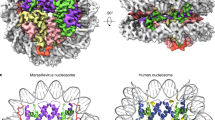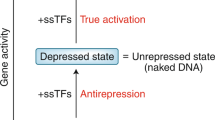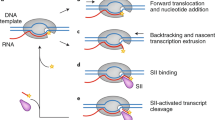Abstract
In vitro nucleohistones are known to be less efficient templates for RNA polymerase than free DNA1–3, but there has been some disagreement as to whether this is due to a real inhibition of RNA synthesis by histones or to their aggregation into precipitates which the reagents cannot penetrate4. Sonnenberg and Zubay5 supported the second suggestion by showing that ultrasonication of nucleohistone which was initially inactive as a template for RNA synthesis caused an increase in activity to about one-third that of free DNA, and Roy and Zubay6 have recently made similar observations using a mammalian polymerase. Bonner and Huang7, however, have repeated their claim that it is possible to prepare soluble nucleohistones which show the inhibition by histones.
This is a preview of subscription content, access via your institution
Access options
Subscribe to this journal
Receive 51 print issues and online access
$199.00 per year
only $3.90 per issue
Buy this article
- Purchase on Springer Link
- Instant access to full article PDF
Prices may be subject to local taxes which are calculated during checkout
Similar content being viewed by others
References
Bonner, J., and Huang, R. C., J. Mol. Biol., 6, 169 (1963).
Barr, G. C., and Butler, J. A. V., Nature, 199, 1170 (1963).
Hindley, J., Biochem. Biophys. Res. Commun., 12, 175 (1963).
Zubay, G., in The Nucleohistones (edit. by Bonner, J., and Ts'o, P.), 95 (Holden Day Inc., London, 1964).
Sonnenberg, B. P., and Zubay, G., Proc. US Nat. Acad. Sci., 54, 415 (1965).
Roy, A. K., and Zubay, G., Biochim. Biophys. Acta, 129, 403 (1966).
Bonner, J., and Huang, R. C., Biochem. Biophys. Res. Commun., 22, 211 (1966).
Chamberlin, M., and Berg, P., Proc. US Nat. Acad. Sci., 48, 81 (1962).
Kay, E. R. M., Simmons, N. S., and Dounce, A. L., J. Amer. Chem. Soc., 74, 1724 (1952).
Phillips, D. M. P., and Johns, E. W., Biochem. J., 72, 538 (1959).
Barr, G. C., and Butler, J. A. V., Biochem. J., 88, 252 (1963).
Doty, P., McGill, B., and Rice, S. A., Proc. US Nat. Acad. Sci., 44, 432 (1958).
The Nucleohistones (edit. by Bonner, J., and Ts'o, P.) (Holden Day Inc., London, 1964).
Chambon, P., Ramuz, M., and Doty, J., Biochem. Biophys. Res. Commun., 21, 156 (1965).
Allfrey, V. G., Cancer Res., 26, 2026 (1966).
Stedman, E., and Stedman, E., Nature, 166, 780 (1950).
Zubay, G., and Doty, P., J. Mol. Biol., 1, 1 (1959).
Author information
Authors and Affiliations
Rights and permissions
About this article
Cite this article
BUTLER, J., CHIPPERFIELD, A. Inhibition of RNA Polymerase by Histones. Nature 215, 1188–1189 (1967). https://doi.org/10.1038/2151188a0
Received:
Issue Date:
DOI: https://doi.org/10.1038/2151188a0
This article is cited by
Comments
By submitting a comment you agree to abide by our Terms and Community Guidelines. If you find something abusive or that does not comply with our terms or guidelines please flag it as inappropriate.



